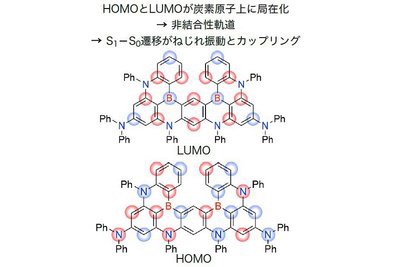
JNC Petrochemical:Ultra-high-purity blue light-emitting material: For organic EL display (OLED)
July 16, 2019
Kwansei Gakuin University:
JNC Petrochemical Corporation:
The joint research team successfully developed a blue light-emitting material for organic EL displays.
This blue luminescent material maintains color purity exceeding that of quantum dots and LEDs.
Organic EL display: (OLED)
Practical use is progressing as a flat panel display to replace liquid crystal displays.
Organic light-emitting material: Advantages Disadvantages
Conventional drawback: Low color purity of light emission
Organic light-emitting materials have the disadvantage of low emission color purity (wide emission spectrum width).
If the color purity of the luminescence is low, it cannot be used as it is on the display.
It is necessary to remove unnecessary colors (emission spectrum) and improve color purity with an optical filter.
If the color purity of the light emission is low, the brightness and power efficiency of the display are greatly reduced.
Actually, there is a limit to the improvement of color purity by the filter.
Currently, it is difficult to widen the color gamut of displays, and the development of luminescent materials with high color purity has been desired.
Newly developed: Luminescent material with high color purity
Prof. Hatakeyama introduced two boron atoms and four nitrogen atoms at appropriate positions in the light-emitting molecule.
By superimposing the resonance effect, we succeeded in suppressing the stretching vibration that is the cause of the broadening of the emission spectrum.
Organic blue light emitting material: (ν-DABNA)
We have succeeded in developing an organic blue light emitting material (ν-DABNA) with a color purity exceeding that of gallium nitride LEDs and cadmium quantum dots.
Research team: DABNA developed
In 2016, we successfully developed DABNA as a prototype of ν-DABNA.
Currently used in organic EL displays for high-end smartphones.
The newly developed ν-DABNA has color purity and luminous efficiency much higher than DABNA.
Higher color gamut, higher brightness, lower power consumption and reduced blue light can be expected for organic EL displays.
The results of this research will be published in the online bulletin of the British scientific journal “Nature Photonics” on July 15, 2019 (UK time)
British bulletin “Nature Photonics” online bulletin version
https://www.nature.com/articles/s41566-019-0476-5
JNC Corporation